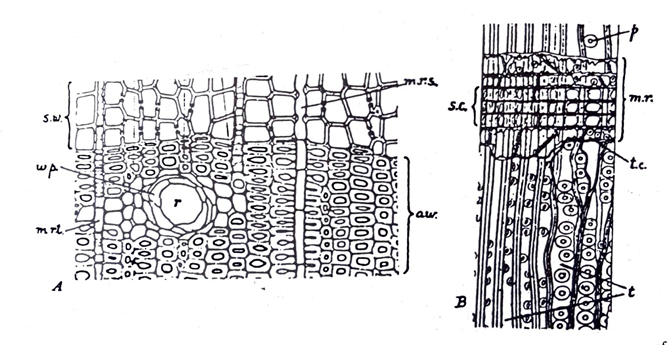Synonyms
Rect Deal, Yellow Deal, White Deal
Botanical Source
Red or Yellow Deal consists of the wood of Pinus sylvestris Linn. and that of Picea excelsa Link constitutes the White Deal. Other species of Pinus and Abies also yield similar woods. These plants belong to the family Pinaceae.
Deal Geographical Source
Deal plants are grown in many European countries, North America and Canada.
Microscopical Characters
Deal wood is straight grained and splits readily longitudinally with smooth surfaces. It is soft in texture and buff in colour has a density of about 0.35 to 0.8 and possesses a resinous odour. Annual rings are well marked, pores absent but resin ducts occur in the central and outer part of each annual ring. The medullary rays appear as fine whitish lines.
Microscopical Characters
The wood consists almost entirely of narrow long tracheids having pits on the radial walls. The pits are large, circular and bordered. Schizogenous resin ducts are abundant in the middle region of each annual ring. Thin-walled parenchymatous cells occur surrounding. the resin ducts. Both uniseriate and multiseriate medullary rays are present, which are composed of elongated rectangular or rhomboid parenchymatous cells.

Fig. 52: Deal. A, a t.s. of the wood through an annual ring; B, a radial l.s. of the wood. aw., autuman wood; m.r., medullary ray; m.r.s., starch cells of medullary ray; m.r.t., tracheidal cells of medullary ray; p.i. bordered pit; t, resin. duct; s.c., starch tells; s.w., spring wood; t, tracheids; t.c. tracheidal cells; w.p., wood parenchyma. (Reconstructed from Wallis).
Chemical constituents
Deal contains about 57 percent of cellulose, 25 percent of lignin, about 1 percent of resin (Colophony) and a small quantity of volatile oil (Turpentine)
Uses of Deal
Deal is used as the chief source of wood cellulose and for making mechanical wood pulp.

